3. Services to Electors – Report on the 43rd General Election of October 21, 2019
For this general election, the agency carried out several initiatives to improve services to electors and make it even easier for them to exercise their democratic right to vote.
3.1. Voter Registration
Elections Canada maintains the National Register of Electors, a database of Canadians who are 18 years or older. The Register is regularly updated between and during elections, using data received directly from electors, administrative data received through agreements with federal, provincial, and territorial agencies, and data received from other sources, in accordance with the Canada Elections Act. This administrative data comes from well-known sources including the Canada Revenue Agency, Immigration, Refugees and Citizenship Canada, most provincial and territorial agencies responsible for driver licencing and vital statistics, and provincial and territorial electoral management bodies. While Immigration, Refugees and Citizenship Canada is a long-standing Register data source for the identity of new Canadian citizens, the passage of Bill C-76 also allowed this department to provide Elections Canada with data on foreign nationals and permanent residents in Canada in order to better ensure the integrity of the Register. New Bill C-76 provisions also authorized the Canadian Armed Forces to provide Elections Canada with data on its members who are electors.
When an election is called, the agency uses data from the Register to produce the preliminary lists of electors, which are provided to registered and eligible political parties and to the returning officers. Returning officers then provide the lists to local confirmed candidates as required by the Canada Elections Act. The preliminary lists are also used to produce voter information cards (VICs), and as a basis for the revised lists of electors (with elector information added during the revision period) and the official lists of electors (the lists used on election day). Under a new provision brought about by the passage of Bill C-76, the revised and official lists—which were already available to candidates during previous elections—were also made available to registered political parties during the election period.
Statistical figures in this report related to revision, registration counts, or voter turnout are the ones that were available at publishing time. Final numbers will be available upon publication of the Official Voting Results on the Elections Canada website by the end of March 2020.
Coverage, accuracy and currency
The quality of the information held in the Register is key to ensuring that electors receive a VIC at their current address. It is also important to political parties and candidates wanting to engage with electors. There are three parameters of quality to the Register:
- Coverage is the proportion of all eligible electors (that is, Canadian citizens who are 18 or older) who are registered to vote. It has historically varied between 91 and 94 percent, but was at 96.4 percent at the start of the 2019 general election when the preliminary lists of electors were issued. The proportion of eligible electors between 18 and 24 years old who were on the lists remained significantly lower, at 77 percent, although there was an increase of 5 percent from 2015.
- Accuracy is the proportion of registered electors whose address is current. These electors are correctly registered at their current address and would have received their voter information card. It has historically varied between 88 and 91 percent, but was at 93.3 percent at the start of the 2019 general election when the preliminary lists of electors were issued. This is compared with 91 percent in 2015 and 90 percent in 2011.
- Currency is the proportion of all eligible electors who are registered at their current address, historically varying between 81 and 86 percent, but which was at 89.9 percent at the start of the 2019 general election when the preliminary lists of electors were issued.
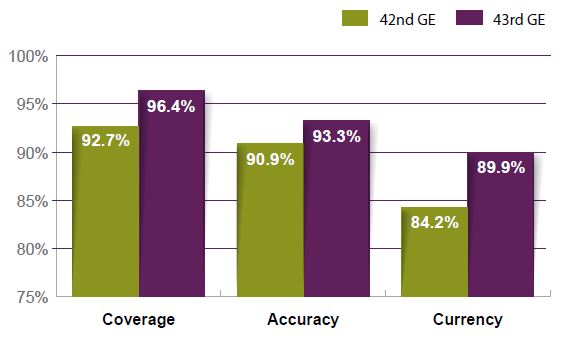
Text version of "Quality of the preliminary lists of electors"
Initiatives to improve the accuracy of the Register
Many factors can affect the quality of the data on the Register, including demographic changes and the timely availability of data. To maximize the accuracy of the list of electors before the general election, Elections Canada undertook several special initiatives earlier in 2019, beyond the processing of its regular data sources:
- In January and September of 2019, the agency mailed letters to potential new electors (between 18 and 27 years old) directing them to its online platform to complete their registration and verify their eligibility. More than 41,000 new electors were added to the Register as a result of this initiative.
- In the spring of 2019, Elections Canada sent verification letters to 250,000 electors who were in the Register, but whose records had not been updated through our various data sources since before the 2015 general election. As required by law prior to removing them from the Register, the agency wrote to these electors and asked them to confirm the accuracy of their information. As a result, some 223,000 elector records were removed from the Register.
- The passage of Bill C-76 gave Elections Canada the authority to obtain information on foreign nationals and permanent residents in Canada from Immigration, Refugees and Citizenship Canada (IRCC). In June 2019, the agency mailed letters to people who were potentially not qualified to vote based on this new information. The letter informed them that they would be removed from the Register unless they confirmed that they were qualified to vote. Over 74,000 persons did not respond and were removed from the Register in August 2019.
- As a result of cross-referencing administrative data, including the new IRCC data, with individual records of potential electors who had previously consented and stated that they were qualified to vote, the agency was able to add more than 900,000 electors to the Register before the call of the election.
All of these activities allowed Elections Canada to greatly improve the accuracy of the Register, leading to the highest quality ever recorded in the preliminary lists since its creation 20 years ago. The retrospective report will include more analysis on the quality of the lists, comparisons to previous years, and the effectiveness of the quality improvements.
Revision period and election day registrations
The purpose of revision is to update the preliminary lists of electors for use at advance polls and on election day. The revision period ran from September 11 to October 15, 2019.
When the writs were issued on September 11, there were 26,927,849 electors on the preliminary lists, or 96.4 percent of the estimated 27,310,979 eligible electors across Canada. An estimated 89.9 percent of registered electors were listed at their current addresses. Elections Canada provided the preliminary lists to the registered and eligible political parties that requested them, and returning officers provided the lists to candidates for their electoral districts.
Over the course of the revision period, some 957,405 Canadians were added to the lists or had their information updated (in 2015, this number was 1.75 million). Of the 957,405 revisions, 157,828 resulted from data supplied by Elections Canada's partners (compared with 948,000 in 2015), 537,049 were completed at Elections Canada offices or through targeted revisions in certain neighbourhoods. The remaining 262,528 were completed online (compared with 301,000 in 2015). There are two reasons for the 45 percent overall decrease in revisions since 2015. First, the election was called earlier than anticipated. Also, there was a higher than average number of revisions based on data supplied by Elections Canada partners. This data was applied during the election period rather than before it. However, this is an area in which analysis is ongoing and the results will be provided in the retrospective report.
For the 2019 election, 638,097 electors registered at their polling place on election day; this represents 5 percent of all election day electors, a decrease from 5.8 percent in 2015.
In all, the final lists of electors include 27,372,715 names, representing a net increase of 444,866 over the preliminary lists.
Online registration
Before the election, Elections Canada's online voter registration service allowed eligible electors to check if they were registered to vote, register or update their voter information. This was the second general election in which online registration was available during the election period. For this election, the agency made the online voter registration service more user-friendly and accessible, and enabled secure uploading of identity documents for registration, rather than through a paper process. This new feature led to more than 33,000 new electors being added to the lists before election day.
Elections Canada actively promoted online registration during both the new pre-election and election periods. More than two million users accessed the online voter registration service during the election period to check whether they were registered to vote, and more than 80,000 successfully added themselves to the lists. Of these, 75 percent (60,000 electors) were between the ages of 18 and 24. A further 200,000 electors updated their voter information online (typically address changes or corrections).
3.2. Ways to Vote
Elections Canada strives to provide as many opportunities as possible for electors to exercise their right to vote. More and more Canadians are choosing alternatives to voting on election day, including advance polling, voting at an Elections Canada office or on a post-secondary campus, voting by mail or other special ballot methods. As mentioned in Section 2.2, special efforts were also made during preparations for the general election to increase the number of advance and election day polling places on First Nations reserves. As a result of these efforts, Elections Canada was able to increase the number of on-reserve polling places for the 2019 general election to 389 (from 366 in 2015).
With 67 percent of registered electors casting ballots in the 43rd general election, voter turnout declined slightly from the 20-year peak of 68.3 percent in 2015. Table 2 in the Appendix provides further details on voter turnout.
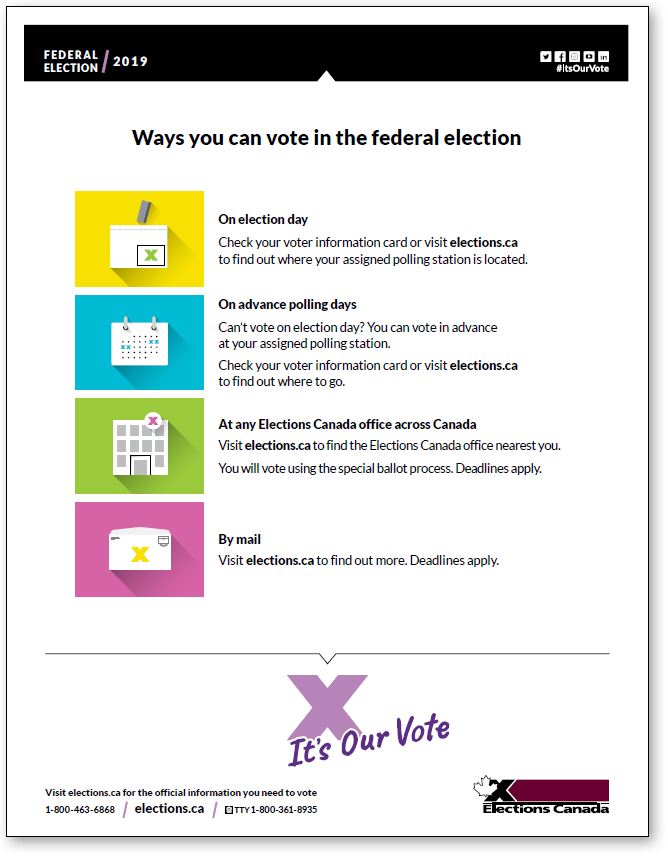
Text version of "Voting options infographic"
Optimizing the voting process
In 2016, Elections Canada launched a multi-year project to transform voting operations at advance and election day polls. Its goals are to reduce wait times, ease the administrative burden on election officers and improve record keeping to incrementally introduce a new service model that takes advantage of information technology. In the 43rd general election, the service model was optimized but not radically transformed, and legislative changes from the passing of Bill C-76 were incorporated. However, anecdotal evidence suggests that Elections Canada's service model at polling stations remains labour-intensive and complex to administer for election day workers. This is an area where Elections Canada must continue to make improvements within the framework imposed by the Canada Elections Act.
As noted later in this section, there were also improvements to the special ballot voting process in Elections Canada offices. In previous general elections, registration services were separate from special ballot voting services. This meant, for example, that an elector wanting to update their registration and to register to vote at their Elections Canada office would have to meet with two election workers separately. The new service model integrated these services, which were performed by a single service agent. To accommodate this change, and add flexibility to their service offerings, election officers were trained on all procedures offered in an Elections Canada office, rather than for a specific function. Time and motion studies conducted before the election suggested that total transaction times would be reduced from 12–15 minutes to 4–7 minutes per elector.
Voting at assigned polling stations during advance polling days
Bill C-76 extended advance polling hours to 12 hours on each day of advance polling, a measure applied for the first time during a general election. To accommodate an expected higher voter turnout on advance polling days and to reduce the distances to polling places for electors, the Chief Electoral Officer instructed returning officers to increase the number of advance polling stations. Over the Thanksgiving weekend, a total of 6,166 advance polls were set up from October 11 to 14, which represents an increase of 1,220 polls (24.7 percent) from the 42nd general election.
The upward trend of Canadians voting at advance polls continued in the 43rd general election. In 2019, more than 26 percent of electors who cast a ballot did so at their assigned polling station during advance polling days. This proportion was slightly under 21 percent in 2015 and slightly above 14 percent in 2011. For the 43rd general election, a total of 4,879,312 electors cast ballots at advance polls. This is a 32.7 percent increase over the 42nd general election, in which 3,677,217 electors cast ballots at advance polls, and a 131.1 percent increase over the 41st general election. Preliminary indications are that there were no systemic issues with long lineups (as was the case in 2015 at many advance polls) even though more electors cast a ballot during advance polls this time than during the last general election.
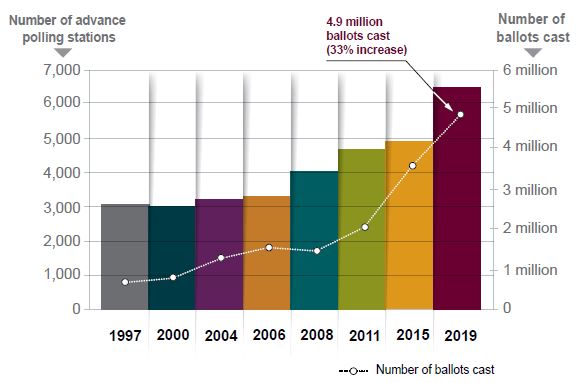
Text version of "Number of advance polling stations and ballots cast, 1997–2019"
Voting at assigned polling stations on election day
Anticipating that a greater number of electors would choose to vote in advance rather than on election day, the agency increased the average size of polling divisions. On election day, returning officers set up 64,672 stationary polls, representing a decrease of 1,352 (2.1 percent) over the 42nd general election. These polls were located at 15,482 polling places, which is comparable to the 42nd general election.
Moreover, 1,981 mobile polls visited 5,334 establishments, an increase of 94 polls (5 percent) over the 42nd general election.
With nearly 70 percent of all ballots cast—corresponding to about 12.8 million Canadians—on election day, this method of voting continues to be the preference of the vast majority of Canadians. This figure is nonetheless the lowest percentage ever recorded in Canadian federal elections and attests to the rise of the popularity of advance voting.
Voting by special ballot
Under the Special Voting Rules provisions of the Canada Elections Act, electors can register to vote by special ballot from the first day of the election period up until six days before election day. Electors can vote at any Elections Canada office or by mail. Incarcerated electors, Canadian Forces electors, and electors temporarily in acute care facilities are also able to vote by special ballot on specific days during the election period. In the 2019 general election, the agency also established additional special ballot service points under exceptional circumstances. These are discussed in Section 3.3.
For the 2019 general election, a total of approximately 660,000 electors voted by special ballot, compared with about 619,000 electors in the 42nd general election, a 6.7 percent increase. This represents 3.6 percent of electors who voted. Further analysis of changes to the special voting rules, the convenience of the special ballot process and the public's response to these voting options will be included in the retrospective report.
Table 3 in the Appendix provides a breakdown of special ballot voting by category.
Voting at Elections Canada offices
As in past general elections, electors could vote by special ballot at any Elections Canada office across the country. This was the first general election during which office staff could fully process local and national electors (that is, electors voting outside of their own electoral districts) at Elections Canada offices. This improvement, combined with the newly streamlined paperwork and voting processes, improved processing times and service to electors.
Vote on Campus offices
After a successful pilot at dozens of post-secondary campuses, Friendship Centres and YMCAs during the 42nd general election, Elections Canada made Vote on Campus a national program in the 43rd general election, this time focusing exclusively on post-secondary campuses. This involved 119 external service point offices at 98 institutions in 86 electoral districts. The agency expanded the program to five days, October 5 to 9, compared to four days in the previous election. While any elector could vote at these offices, most were students. More than three quarters of electors who voted at external service point offices were from outside their home electoral district.
The turnout increased every day that Vote on Campus was available, peaking at around 48,000 on October 9. In all, more than 110,000 electors voted at these locations, compared with about 70,000 in 2015. Further analysis will be provided in the retrospective report.
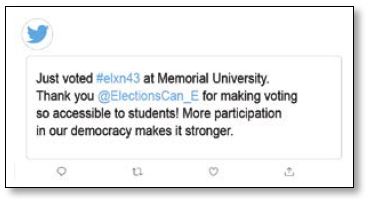
Text version of "Vote on Campus feedback"
Voting by mail
All Canadian electors, whether in Canada or abroad, can apply online or by mail for special ballot voting kits to be mailed to them.
International
On January 11, 2019, the Supreme Court of Canada declared paragraphs 222(1)(b) and (c), 223(1)(f) and 226(f) of the Canada Elections Act to be of no force or effect. These provisions, which prevented Canadians living abroad for more than five years from voting by special ballot, were repealed by Bill C-76. The repeal led to a surge in Canadians registering on the International Register of Electors (55,000 compared to 16,000 in 2015) and ballots received from electors living abroad, with 34,144 international electors casting ballots (compared to 11,001 in 2015). The top five jurisdictions where ballots were requested were the United States (43%), the United Kingdom (11%), China and Hong Kong (5%), Australia (4%) and Germany (4%).

Text version of "Ballots cast by Canadians abroad"
Technical challenges related to special ballot registration
Approximately 80,000 electors registered online to vote by mail (domestic and international combined) in this election. To register to vote by mail, electors must submit a complete application for approval by 6 p.m. on the sixth day before voting day. Due to a technical issue, 118 of those online applications submitted close to the deadline were received by the agency after the deadline. Unfortunately those electors did not receive a voting kit. An administrative review is underway to identify the root cause of this issue and address it before the next election.
Other special ballot voting
Canadian Armed Forces members
The passage of Bill C-76 brought about changes to the Canadian Forces voting program. Elections Canada liaises closely with the Canadian Armed Forces to facilitate voting at military polling locations between 14 and 9 days before election day. In 2015, about 29,000 military personnel voted at these polling locations. However, since the passage of Bill C-76, Canadian Forces electors can now also choose any available voting method: at an Elections Canada office, by mail, or at their assigned polling station on advance polling days or election day. As a result, about 19,000 military personnel voted at military polls in 2019, a 34 percent decrease.
Voting in acute care facilities
During the 42nd general election, the agency facilitated voting in 760 acute care facilities. In 2019, Elections Canada facilitated voting in 794 acute care facilities on October 13, 14, and 15. Hospitalized electors were notified on October 12 that election officers would visit on those days to give them the opportunity to vote by special ballot. They were also advised to call their Elections Canada office if they preferred to schedule a visit.
Depending on the institution, an election officer would visit each room or meet electors by appointment. The officer used paper forms to register electors and leveraged the Voter Information Service on Elections Canada's website to confirm the elector's correct electoral district. Officers later entered the data from the forms at the Elections Canada office.
Incarcerated electors
Voting by special ballot took place in 52 federal, 104 provincial adult, and 57 youth correctional facilities on October 9. This was two days earlier in the electoral calendar than in previous elections, as a result of Bill C-76 coming into force. The incarcerated voting program also facilitated the vote for electors residing in 209 halfway houses (community correctional facilities and community residential facilities) across Canada.
3.3. Adapting Services
Accommodation of religious observances
As noted in Section 2.10 above, Elections Canada developed an action plan to accommodate electors observing Jewish holidays. Returning officers worked with Jewish community leaders in 54 of 338 federal ridings (where adjusted 2016 Census data showed the Jewish population to be over 1 percent) to design local solutions to meet community needs. The goals of this work were to enhance election services to facilitate voting during times that observant Jews were not restricted from voting, and to raise awareness in the Jewish community about these enhanced services and options. Based on a diverse range of community needs and as determined in consultation with local community members, the agency set up 27 special voting kiosks (open to all eligible electors) for one to four days in 15 electoral districts, serving 7,221 electors who took advantage of the offering. Some 19 long-term care facilities with primarily Jewish residents where mobile polls had been established in previous general elections could not accommodate mobile polls on election day during the 43rd general election. Electors residing at those 19 long-term care facilities were served through the acute care voting model mentioned above. In some cases Elections Canada offices increased their capacity and service hours to accommodate the needs of these communities. Relevant voting service options were actively promoted through an information campaign and engagement with national organizations (CIJA and B'nai Brith), Jewish media and community leaders.
The agency's accommodation of religious observances will be revisited in future reports.
Response to storms in Manitoba
Severe storms caused considerable snow accumulations and major power outages in parts of Manitoba, triggering a state of emergency. This disrupted plans for advance polls in several electoral districts. Some communities were evacuated and polls did not open as planned, while others opened on a reduced schedule due to intermittent power outages. The Chief Electoral Officer authorized the closing of advance polling places affected by the winter conditions and outages. Some electoral districts continued to experience power outages, road closures, and flooding through election day.
Elections Canada implemented a series of extraordinary measures to accommodate electors who did not have the opportunity to vote at advance polls because of evacuations or power outages.
The agency set up an additional polling place at the University of Winnipeg's Convocation Hall for evacuees from 14 communities in four affected electoral districts: Churchill–Keewatinook Aski,
Dauphin–Swan River–Neepawa, Portage–Lisgar, and Selkirk–Interlake–Eastman. Elections Canada worked with the Canadian Red Cross to transport evacuees to the polls. About 270 electors used this voting option, and ballots were counted on site at the end of election day.
The agency also accommodated emergency workers—mostly from Ontario, Saskatchewan, and Manitoba—who had been deployed in Manitoba to restore power and telecommunications services and who were unable to make it to their assigned polling station on election day. The agency opened two additional service points, one in the community of Lundar and the other in Portage la Prairie, where workers could vote by special ballot.
These offices were mainly staffed with volunteer headquarters employees, as most field resources were needed elsewhere. Elections Canada closely collaborated with Manitoba Hydro, coordinating voting times to prevent long lines and accommodate workers' schedules. In all, 592 workers used these additional service points.
3.4. New Paper Ballots
In 2018, Elections Canada piloted a new paper ballot in several by-elections. The new front design was developed in consultation with political parties and stakeholder groups, such as disability communities, and focus-tested with a cross-section of Canadians. The new, larger ballot features larger font sizes and displays candidates' surnames in upper-case letters only, to increase legibility. An assessment is needed to determine whether the change in design of the ballot or other factors contributed to an increase in the number of rejected ballots. This examination will be included in the upcoming retrospective report.
Several changes to ballot production improved efficiency and reduced the time needed for printing. Furthermore, Elections Canada developed a new ballot planning and distribution tool to assist the returning officers with the various aspects of ballot planning and production. The tool automated the calculation of the number of ballots required for each electoral district, incorporating factors such as potential high registration, higher advance poll turnouts, and the field office's ability to replenish the ballot supply during the vote. The tool ensured that enough ballots were printed and that they were more appropriately distributed, and that no polling place ran out of ballots.
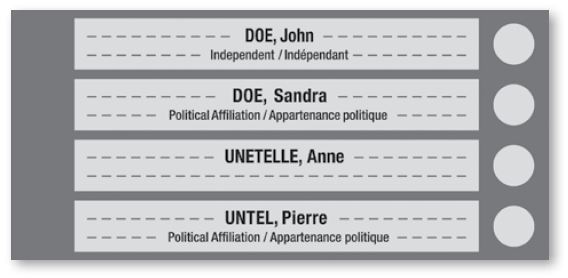
Text version of "New ballot design"
